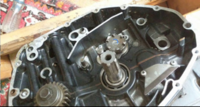burr
XS400 Enthusiast
Out of curiosity – does anyone know if 400cc engines have any known INCOMPATIBILITIES between engines? Mounting locations, sizes of bolts, clutch plates, valve springs, Engine covers, etc.
My busted engine is a "4R5" while my backup engine starts with "1W4." Can't find info on the 14W on any of the "serial number"-type posts on the forum. Maybe @drewpy knows?
Would like to know because I intend to split the busted engine tomorrow, and need to assess which parts I have and which parts I will need. Thanks!
My busted engine is a "4R5" while my backup engine starts with "1W4." Can't find info on the 14W on any of the "serial number"-type posts on the forum. Maybe @drewpy knows?
Would like to know because I intend to split the busted engine tomorrow, and need to assess which parts I have and which parts I will need. Thanks!


